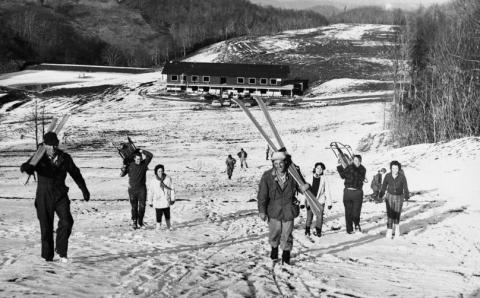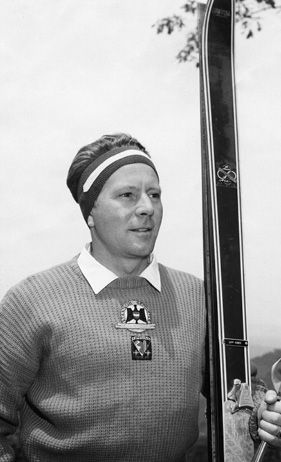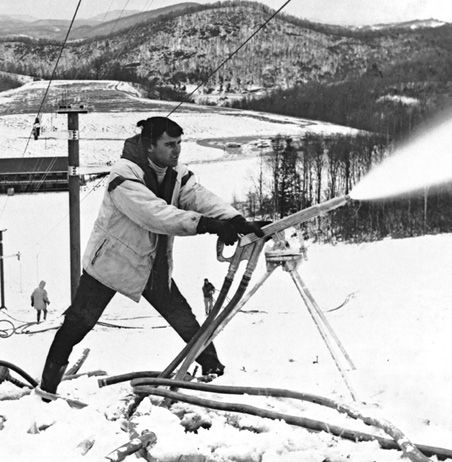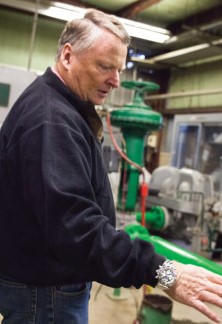
How Vermonters, Austrians and Swiss launched skiing below the Mason-Dixon Line.
Yankee skiers often assume that Mount Washington is the highest peak in the eastern United States, but it ain’t. More than a dozen mountains in the southern Appalachians are higher, and they even host some 17 ski resorts. The base village at Beech Mountain, North Carolina, sits more than 1,000 feet higher than the top of Mt. Mansfield’s lift network, Vermont’s highest.
Photo top of page: During 1962 construction of Blowing Rock Ski Lodge in North Carolina, early snow sent skiers hiking. Photo courtesy Appalachian Ski Mountain.

Johnson collection.
Mile-high ranges wring snow out of storms coming from the moist Mississippi Basin and the Great Lakes. More important, typical overnight temperatures at those elevations allow great snowmaking—on average eight hours each night from mid-December to late March. On a winter’s day at the summit of 5,506-foot Beech Mountain, a New England skier would feel right at home.
Long before the first skiers arrived, early settlers noted the wintry weather. In 1752, Bishop Augustus Spangenberg wanted to establish a new settlement but was turned back by a blizzard near what would become Boone, North Carolina. During the Revolutionary War, the Overmountain Men trudged through September snow while crossing Roan Mountain en route to defeat Loyalists at the Battle of Kings Mountain, South Carolina. And in 1856, snow stopped mail carriers crossing the Blue Ridge Mountains near Cheat Mountain, today the site of West Virginia’s Snowshoe Mountain ski resort—with average snowfall of almost 200 inches.
Moreover, cool summers meant that by the late 1800s, the high mountains bloomed with resort hotels like Blowing Rock’s Green Park Inn (opened in 1891), where the rich escaped baking lowlands. Railroads made access easy in some spots.
Waldo Holden
During the Depression years, lift-served resorts triggered a boom in skiing across the northern states, and skiers who moved south brought the sport with them. In 1936, federal employees from New England and the Sierra founded the Ski Club of Washington, D.C. (SCWDC). Their first project was to find snow nearby. Waldo Holden, a D.C. lawyer from Vermont and the club’s first president, scouted Washington’s environs and found snowy hills in Glencoe, Pennsylvania, 150 miles northwest of Washington. The club ran seven ski trains there during that first winter.
Thereafter, snow proved unreliable and the search roamed south. In 1939, workers from the Civilian Conservation Corps (CCC) cut the Whiskey Hollow Trail at New Germany State Park in western Maryland, billed as “the only expert trail south of the Mason-Dixon line.” It was only a three-hour drive from Washington. For the 1939-40 ski season, SCWDC persuaded nearby landowners Samuel and Lorraine Otto to operate a 600-foot rope tow powered by a 1935 Dodge truck donated by the CCC.
About the same time, the new Great Smokies Ski Club began skiing at Newfound Gap, on the border between North Carolina and Tennessee. Great Smoky Mountains National Park opened in 1934, and the Park Service built an all-weather road through the gap. Skiers could drive to a parking lot at the top of the pass. It was a 500-mile drive from D.C. but only 50 from Knoxville, Tennessee.
Legend has it that after World War II, airline pilots flying in and out of Washington National Airport spotted large snowdrifts in the hills near Davis, West Virginia, about 150 miles west of D.C. There SCWDC connected two mega-drifts with tows in 1951 to create Driftland, which evolved into the Cabin Mountain Ski Area a few years later.
Bob Barton
Thus far, every ski tow in the area had been a ski club venture. That changed in 1955, when Bob Barton, then 27 and a graduate of the University of Virginia law school and the United States Air Force, set up a commercial tow on Weiss Knob, adjacent to Driftland. He wanted to put in snowmaking, but the site was too windy. So in 1959 he moved to the lee side of the ridge, a mile away, and put in the pipes and pumps. That winter the U.S. Weather Bureau measured 452 inches of natural snow in the Canaan Valley. Barton couldn’t keep his access road open. Today, the area operates as the White Grass Ski Touring Center.

Stowe to lead Virginia's
Homestead Resort, 1959. Randy
Johnson collection.
Sepp Kober
Barton felt he’d need the cachet of a European ski instructor at the new hill. He contacted the Austrian consulate in New York and was referred to Joseph H. “Sepp” Kober, an Austrian instructor then teaching at Stowe. When Kober showed up in 1958, said Barton, “I could see immediately that there was nothing in Canaan Valley appropriate to a man of his background. Sepp was destined for greater things.”
So Kober moved to the classic spa and golf resort the Homestead, in Hot Springs, Virginia, and launched a ski area there in 1959. With a mere 2,500-foot base elevation and in the snow shadow of West Virginia’s high peaks, the Homestead may have been the first ski area designed from the start to subsist solely on machine-made snow. It opened as the only other resort to build a Cranmore-style Skimobile lift, serving an easy 700-foot vertical.
The ski area occupied less than 2 percent of the Homestead’s property, but the 483-room hotel, with a history stretching back before the Revolutionary War, had the marketing power to pull in skiers. Kober made the most of the modest terrain. He repped for Beconta and other ski-industry companies, and installed a cadre of Austrian instructors, many of whom became influential elsewhere in North America. In 2009, on the Homestead’s 50th anniversary of skiing, Kober was inducted into the U.S. National Ski and Snowboard Hall of Fame. He died a year later, at age 88.
Rolf Lanz and Claude Anders
On the western side of the Smokies, a ski resort debuted above Gatlinburg, Tennessee, in 1962. The city owned land along the Newfound Gap Road, including a 3,300-foot peak about 2,000 feet above town. It offered a potential 600 vertical feet of skiing, and the city leased the land to a private ski club.
Rolf Lanz, a native of Bern, Switzerland, had moved to Atlanta in 1953 and worked there as a hairdresser. He became a Gatlinburg regular and in 1965 jumped at the chance to become ski school director. In 1973, real estate developer Claude Anders built a 120-passenger aerial tram—at the time the world’s largest—from the town to the mountain, then purchased the resort itself two years later. Lanz dubbed it Ober Gatlinburg.

development at Blowing Rock.
Appalachian Ski Mountain photo.
Bill Thalheimer and Tony Krasovic
In 1962, the first of today’s resorts came to the High Country corner of North Carolina, when movie theater entrepreneur Bill Thalheimer debuted the Blowing Rock Ski Lodge. Ski pros were sparse, and Sepp Kober connected Thalheimer with Austrian instructor Tony Krasovic. He agreed to come south to run a resort but admitted later, “I didn’t know the only thing there was a parking lot!”
While Thalheimer handled financing and publicity, Krasovic managed the hill. He kept the resort making snow as the business struggled. Kober and Krasovic were the only Southerners at the founding of the National Ski Areas Association at Colorado’s Broadmoor Resort in 1962.
In 1968, after a stockholder squabble, Grady Moretz and four partners arranged a friendly takeover from the bank. The resort was renamed Appalachian Ski Mountain and found success as a family-friendly resort. The next winter, Jim Cottrell and Jack Lester arrived to promote their ironically named French-Swiss Ski College. By selling ski lessons in bulk to colleges and even to the U.S. Army and Navy (from 1969–76), they taught GLM skiing to hundreds of thousands of new skiers—an outrageous tale that deserves its own article in a future issue of Skiing History.
Kober protegés Manfred and Horst Locher opened Bryce Resort in Virginia in 1965. The 500-foot-vertical ski area had the advantage of location, less than two hours from downtown Washington. The Lochers, in turn, imported more European pros, including Gunther Jöchl, a Bavarian-educated Austrian ski racer, in 1971.

Sugar and Snowshoe resorts.
Doc Brigham
Dr. Thomas “Doc” Brigham, who grew up in Vermont and was an avid skier, was stranded in Birmingham, Alabama, teaching dentistry at the University of Alabama. He also maintained a private practice. His wife showed him an article in Reader’s Digest about snowmaking at the Homestead. Convinced the South could have a vibrant ski industry, Brigham set out to find a mountain.
He found two, in fact, near Banner Elk, North Carolina. He liked the 5,236-foot summit of Sugar Mountain, a few miles south of town, but couldn’t make a deal for the land there. Instead, he purchased an option on the upper slopes of Beech Mountain, north of town and at more than 5,500 feet high. To finance the lifts and lodge, Brigham’s group sold the land to the three Robbins brothers, who had made money developing local tourist attractions. Their idea was to develop Beech real estate, along with a sister condominium resort on St. Croix in the U.S. Virgin Islands.
Beech opened in the winter of 1967–68 and soared to the top spot in the emerging Southern ski industry. A national marketing blitz brought an upscale clientele for second homes.
Brigham felt the investment group spent more than he liked on the Virgin Islands venture. So he decamped and returned to Sugar Mountain, where he was now able to strike a deal with landowners George and Chessie MacRae. Sno-Engineering’s Sel Hannah designed the new resort, with Stein Eriksen’s endorsement. The slopes opened on December 19, 1969. Austrian instructor Erich Bindlechner ran the ski school, fresh from his previous post as assistant ski school director at Killington. In 1971, a former Kober instructor and snowmaker at Bryce named Bob Ash came on as Sugar’s mountain manager—he would later run both Beech and Sugar.
The summer of 1973 brought the OPEC oil embargo, recession and high interest rates, all but halting second-home sales. Real-estate bankruptcies followed. Brigham saw the writing on the wall and bailed again, heading to Cheat Mountain in West Virginia to launch Snowshoe Mountain.
Ash maintained that the debacle of 1973-75 gave Southern skiing an undeserved black eye. “Even during the gas crisis and the bankruptcies, the ski operations at Beech and Sugar and the others were making money,” he said. For a time, Sugar Mountain was the South’s largest ski area.

recovery at Sugar Mountain.
Sugar Mountain photo.
Gunther Jöchl
Brigham’s departure left a vacuum at Sugar, leading to bankruptcy. In 1976, the court leased the mountain to Jöchl and his Blue Knob partner Dale Stancil.
Jöchl, who held a degree in engineering from the University of Munich, solved the snowmaking, grooming and lift problems, elevating Sugar’s skiing. “It used to be unheard of to start skiing before the 15th of December,” he says. “When I came here, I said, ‘It’s gonna get cold. Let’s make snow.’” Sugar started opening in November. “Everybody thought we were nuts,” he says. “By the time they were wondering what we did, we had fantastic skiing, made some money—and got great publicity.” Eventually Jöchl could cover the entire mountain—all 125 acres—with a foot of snow in 36 hours.
In 2011, Jöchl bought out Stancil’s share to become sole owner, along with his wife, Kim, one of the U.S. Ski Team’s Schmidinger twins. Major slope expansions included a double-black diamond run homologated for FIS slalom and giant slalom events and six new lifts, among them six- and four-passenger detachable chairs.
As a young racer in Bavaria, Jöchl’s sponsor was Völkl, and he had become friends with Franz Völkl, Jr. himself. In 1981 Völkl offered Jöchl the U.S. distribution rights to the brand. Until 1995, one of the world’s premier ski brands was distributed from Banner Elk, North Carolina. Then, for two years, he imported Kneissl skis and Dachstein boots.

photo.
Snowshoe: Brigham’s Final Mountain
Brigham’s new venture, Snowshoe Mountain, grew even bigger than Sugar. It consisted of three lift networks on 257 acres, topping out at 4,848 feet elevation. The west side of the ridge offers an uninterrupted 1,500 feet of steep vertical.
Snowshoe, named for its population of hares, represents that “developed-out-of-nowhere” side of Southern skiing. The resort debuted in 1974 with little lodging, and Brigham realized he couldn’t run a destination resort with nowhere to sleep. Refinancing was needed and the state helped, but Snowshoe’s growing pains continued, with bankruptcies in 1976 and again in 1985, even as the resort became the South’s largest ski area.
Between the bankruptcies Brigham again withdrew from one of his ski resort projects, developing the Euro-style Whistlepunk Village and Inn on the mountaintop. Stability arrived under coal magnate Frank Burford. Acquired by Intrawest in 1995, Snowshoe was hosting nearly a half-million skiers annually by the late ’90s. Over a handful of years beyond the turn of the century, Intrawest spent $100 million building one of its signature resort villages. In summer 2017, Snowshoe stepped up to national Ikon Pass status when it was acquired by Alterra Mountain Company.
Brigham, with long time protégé Danny Seme, moved on to another West Virginia summit, Tory Mountain, but this last resort never opened. Trees again cover its runs. With son Peter, Brigham spent his later years involved in Colorado’s Sunlight Mountain Resort. He passed away in 2008. 
The Other Guys
After the early heyday of natural snow skiing in Canaan Valley, skiing came back in 1971 as the state developed Canaan Valley Ski Resort where Bob Barton’s 1955 original Weiss Knob had been located.
Adjacent Timberline ski area, with 1,000 feet of vertical, opened in 1982 and in 2019 was purchased by Indiana ski area operator Perfect North Slopes after falling on hard times. The new owners installed West Virginia’s first six-person detachable chairlift. Timberline’s two-mile Salamander Run, the region’s longest, is the only Southern slope requiring a U.S. Forest Service public land use permit.
Wintergreen, now Virginia’s biggest ski resort, opened in the winter of 1975–76 with slopes designed by Sel Hannah. Clif Taylor, originator of the graduated length method of ski instruction (GLM), was ski school director. In 1982, manager Uel Gardner, another New Englander, added the ski area’s challenging Highlands slope system, taking the vertical drop just past 1,000 feet.
Randy Johnson is an award-winning travel writer based in Banner Elk, North Carolina. His most recent book is Southern Snow, published in 2019.
